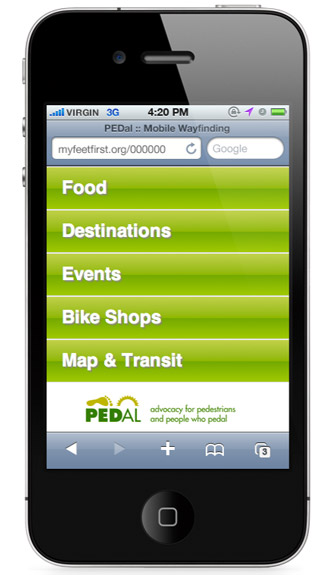 PEDal has developed a QR Code Mobile Wayfinding tool that will help tourists and residents navigate around town.
PEDal has developed a QR Code Mobile Wayfinding tool that will help tourists and residents navigate around town.
There are two ways to implement QR code wayfinding: 1) by displaying a unique QR code on a bike route sign, other city sign pole, or as a plaque in a pedestrian environment and 2) by integrating the QR codes with a paper street or trail map precisely at the same location at which a physical sign would be placed.
Here’s how it works: tourists and residents, alike, simply snap a cell phone photo of the code and instantly determine where they are, what shops, restaurants, transit, beach access points, and other community amenities are in their immediate area, and how long it will take to walk or bicycle there.
Here’s why it works: QR Code Mobile Wayfinding eliminates a visitor’s confusion about whether to drive or walk or bike to a destination that could be just a block away, if only the map of selected information was in the palm of their hand. Now it can be.
How is this different from a simple Google map? Those public domain maps don’t filter for all the visitor-oriented information in one location, so a person must diligently visit multiple websites to find the closest amenities and transit info. People often just give up when accessing information requires too many steps. Moreover, businesses like insurance offices or tax preparers are often included on public domain maps but usually aren’t the type of businesses needed by visitors eager to see what a town has to offer.
QR code mobile wayfinding efficiently connects customers to a destination, something that no traditional wayfinding signage can do.
Advantages of QR Code Wayfinding Signage
- Free to the user: QR-code reading smart-phone applications are available free from a variety sources. Once a person has a smart-phone with that application, all they’ll need is a wireless handheld device to access useful information.
- Cost Effective: QR codes can be printed or applied as a decal to any surface, such as new or existing signs and are adaptable to almost any medium.
- Better information tools than traditional wayfinding signage: QR codes’ adaptability, mobility, and utility provide distinct advantages over physically installed signage.
- Reduce on-going costs: QR code digital mapping tools can replace the need to print paper maps. They’re always in demand year round, especially during the summer season.
- Bicycle tourism & the best of both worlds: PEDal’s QR codes can be integrated with printed paper maps so that amenities at each intersection can be discovered without even being there. That’s extremely important for bicycle tourists who need to know what’s ahead so they can plan their day and overnight stay in your town while conserving energy for long rides.
- Mobility: designed for mobile and handheld wireless devices used by an ever-increasing number of people, especially bicyclists.
- Modifiable & Current: the website underlying the QR code can easily be changed based on changes in the marketplace and physical environment. Traditional brick-and-mortar signage displays only those businesses that existed at the time the sign was created.
- Stimulates local business: Filtered for relevance to pedestrians’ and bicyclists’ needs, the mapping prioritizes locations of local restaurants, service-oriented businesses (like bicycle shops), coffee shops, and popular destinations. Can be linked to digital coupons to encourage patronage of local businesses.
- Designates pathways to natural and recreational amenities like beach access points, surf spots, trailheads, pier, and parks.
- Time Saver: smart-phone screen will display the time required to reach a destination by walking and biking.
- Air Quality & Vehicle Congestion Improvements: for motor-vehicle-reliant people, QR wayfinding promotes a park-once strategy and avoids traveler uncertainty. That makes people to be more likely to choose walking and biking for transportation rather than relying upon their cars and reduces local air pollution and vehicle congestion.
- Public Transit Connections: locates train stations, bus stops, and estimates travel time to and from those sites by walking or bicycling.
- Improved community aesthetics: by utilizing Quick Response (QR) Codes on bicycle or pedestrian wayfinding signs, more information can be conveyed in a physically smaller space. That’s because the smart phones will display desired information instead of clutter-prone physical signs on a pole.
There are a large number of free QR Code readers for both iPhone and Android smartphones.

Leave a Reply
You must be logged in to post a comment.